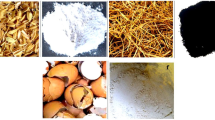Abstract
In this research, multi response Taguchi-grey relational approach was employed to optimize the mixing parameters in cement mortar preparation. The main aim of this present investigation is to find the optimal input variables like surface-modified nanosilica, water to cement ratio and plasticizer to achieve cement mortar with high compressive strength and low water absorption percentage. The surface-modification of nano-silica was done via aqueous solution method using 3-Aminopropyltrimethoxysilane. When the input variables are more than one Taguchi-grey relational approach is a best method since it may give difference set of optimum level for each response. It is observed that the addition of surface modified nano-silica in cement mortar influenced high compressive strength with lower water absorption percentage. According to analysis surface-modified nanosilica of 2 wt%, water to cement ratio of 0.5 and plasticizer of 1 wt% (A3B2C3) is found to be producing highest compression strength of 53.86 MPa and lower water absorption percentage of 3.32. The SEM morphological images revealed uniform dispersion of nano-silica particle in void content of cement mortar.
Similar content being viewed by others
References
Senff L, Hotza D, Repette WL, Ferreira VM, Labrincha JA (2010) Mortars with nano-SiO2 and micro-SiO2 investigated by experimental design. Constr Build Mater 24(8):1432–1437. https://doi.org/10.1016/j.conbuildmat.2010.01.012
Shen W, Zhang C, Li Q, Zhang W, Cao L, Ye J (2015) Preparation of titanium dioxide nano particle modified photocatalytic self-cleaning concrete. J Clean Prod 87:762–765. https://doi.org/10.1016/j.jclepro.2014.10.014
Sanchez F, Sobolev K (2010) Nanotechnology in concrete-a review. Constr Build Mater 24:2060–2071. https://doi.org/10.1016/j.conbuildmat.2010.03.014
Said AM, Zeidan MS, Bassuoni MT, Tian Y (2012) Properties of concrete incorporating nano-silica. Constr Build Mater 36:838–844. https://doi.org/10.1016/j.conbuildmat.2012.06.044
Ltifi M, Guefrech A, Mounanga P, Khelidj A (2011) Experimental study of the effect of addition of nano-silica on the behaviour of cement mortars. Procedia Eng 10:900–905. https://doi.org/10.1016/j.proeng.2011.04.148
Rahmani K, Shamsai A, Saghafian B, Peroti S (2012) Effect of water and cement ratio on compressive strength and abrasion of micro silica concrete. Middle-East J Sci Res 12(8):1056–1061. https://doi.org/10.5829/idosi.mejsr.2012.12.8.3333
Liu X, Chen L, Liu A, Wang X (2012) Effect of nano-CaCO3 on properties of cement paste 2012. Int Conf on Future Energy Environment and Materials, Energy Proceedia 16:991–996. https://doi.org/10.1016/j.egypro.2012.01.158
Mosaberpanah MA, Eren O, Tarassoly AR (2019) The effect of nano-silica and waste glass powder on mechanical, rheological, and shrinkage properties of UHPC using response surface methodology. J Mater Res Technol 8(1):804–811. https://doi.org/10.1016/j.jmrt.2018.06.011
Manzoor Z, Barbhuiya S, Shaikh F, Cheema D (2018) Optimizing the amounts of micro-silica and nano-silica in concrete using response surface method. Proc. of 24th Conf, on Mechanics of Structures and Materials: Advancements and Challenges, pp.1871–1874
Bhanja, S., Sengupta, B. (2002). “Investigations on the compressive strength of silica fume concrete using statistical methods.”Cem Concr Res, Vol.32, No.9,pp.1391–1394, https://doi.org/10.1016/s0008-8846(02)00787-1
ArunPrakash VR, Rajadurai A (2016) Thermo-mechanical characterization of siliconized E-glass fibre/hematite particles reinforced epoxy resin hybrid composite. Appl Surf Sci 384(16):99–106
Arun Prakash VR, Xavier JF, Ramesh G, Maridurai T, Kumar KS, Raj RBS (2020) Mechanical, thermal and fatigue behaviour of surface-treated novel Caryota urens fibre–reinforced epoxy composite. Biomass Conv Bioref. https://doi.org/10.1007/s13399-020-00938-0
Jayabalakrishnan D, Saravanan K, Ravi S, Prabhu P, Maridurai T, Prakash VRA (2020) Fabrication and characterization of acrylonitrile butadiene rubber and stitched E-glass fibre tailored Nano-silica epoxy resin composite. Silicon. https://doi.org/10.1007/s12633-020-00612-0
Ben Samuel J, Julyes Jaisingh S, Sivakumar K, Mayakannan AV, Arunprakash VR (2020) Visco-elastic, thermal, antimicrobial and dielectric behaviour of areca fibre-reinforced nano-silica and neem oil-toughened epoxy resin bio composite. Silicon. https://doi.org/10.1007/s12633-020-00569-0
Du H, Pang SD (2019) High performance cement composites with colloidal nano-silica. Constr Build Mater 224:317–325
Sevim Ö, Demir İ (2019) Optimization of fly ash particle size distribution for cementitious systems with high compactness. Constr Build Mater 195:104–114
Mal'chik AG, Litovkin SV, Rodionov PV (2015) Investigations of physicochemical properties of bottom-ash materials for use them as secondary raw materials. In IOP Conference Series: Materials Science and Engineering 91:012081
Alghdeir M, Mayya K, Dib M (2019) Characterization of nanosilica/low-density polyethylene nanocomposite materials. J Nanomater 2019:1–8
Rego JHS, Nepomuceno AA, Figueiredo EP, Hasparyk NP, Borges LD (2015) Effect of particle size of residual rice-husk ash in consumption of Ca (OH) 2. J Mater Civ Eng 27(6):04014178
Muthuramalingam T, Mohan B (2013) Taguchi-grey relational based multi response optimization of electrical process parameters in electrical discharge machining. Indian J Eng Mater Sci 20:471–475
Pillai JU, Sanghrajka I, Shunmugavel M, Muthuramalingam T, Goldberg M (2018) Guy little fair, Optimisation of multiple response characteristics on end milling of aluminium alloy using Taguchi-Grey relational approach. Measurement 124:291–298
Shoja MZ, Naddaf HE (2017) Optimizing compressive strength of micro- and nano-silica concrete by Statistical method. Civ Eng J 3(11). https://doi.org/10.28991/cej-030939
Arunprakash VR, Viswanathan R (2019) Fabrication and characterization of Echinoidea spike particles and Kenaf natural fibre-reinforced Azadirachta-Indica blended epoxy multi-hybrid bio composite. Composites: A 118:317–326
ArunPrakash VR, Rajadurai A (2017) Inter laminar shear strength behavior of acid, base and Silane treated E-glass fibre epoxy resin composites on drilling process. Defence Technol 13:40–46
Zhang MH, Islam J, Peethamparan S (2012) Use of nano-silica to increase early strength and reduce setting time of concretes with high volumes of slag. Cem Concr Compos 34:650–662. https://doi.org/10.1016/j.cemconcomp.2012.02.005
Sharobim KG, Mohammedin HA (2013) The effect of Nano-liquid on the properties of hardened concrete. HBRC Journal 9:210–215. https://doi.org/10.1016/j.hbrcj.2013.08.002
Senff L, Labrincha JA, Ferreira VM, Hotza D, Wellington L, Repette WL (2009) Effect of nano-silica on rheology and fresh properties of cement pastes and mortars. Constr Build Mater 23:2487–2491. https://doi.org/10.1016/j.conbuildmat.2009.02.005
Author information
Authors and Affiliations
Corresponding author
Additional information
Publisher’s Note
Springer Nature remains neutral with regard to jurisdictional claims in published maps and institutional affiliations.
Rights and permissions
About this article
Cite this article
Vasanthi, P., Selvan, S.S. Optimization of Mixing Parameters in Nanosilica Toughened Cement Mortar Using Taguchi-Grey Relational Analysis. Silicon 14, 127–133 (2022). https://doi.org/10.1007/s12633-020-00791-w
Received:
Accepted:
Published:
Issue Date:
DOI: https://doi.org/10.1007/s12633-020-00791-w




